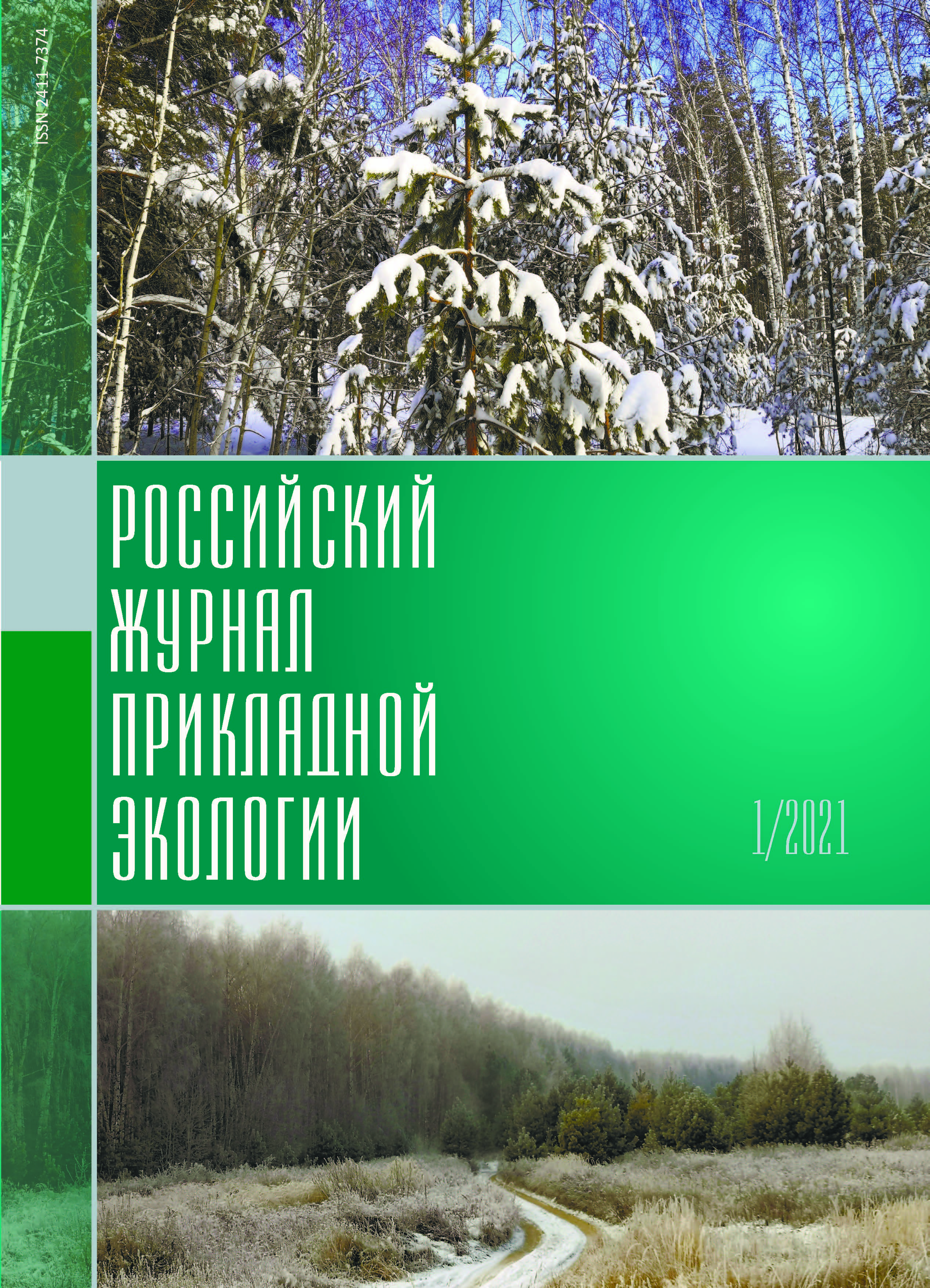Influence of phytorecultivation measures on the activity of the microbial community of oil-contaminated alluvial soddy soil
Keywords:
alluvial soil, petroleum hydrocarbons, basal respiration, substrate-induced respiration, microbial respiration coefficientAbstract
The respiratory activity of reclaimed oil-contaminated alluvial soddy light loamy soil after two successive sowing of monocotyledonous (spring wheat) and dicotyledonous (seed pea) plants was studied. The basal respiration rate (Vbasal) increased with an increase in the residual content of oil products in the soil upon the primary sowing of wheat. Repeated sowing of wheat reduced the Vbasal and leveled the differences between the control and contaminated soil samples. Repeated sowing of wheat stabilized the substrate-induced respiration (Vsir) of the contaminated soil. Both the primary and the repeated sowing conditions showed no significant differences in Vbasal under wheat and pea sowing. Differences between soils sown with different crops were related to Vsir. The secondary sowing of peas led to an increase of Vsir, while in the soil under wheat, Vsir was detected at the control level. Repeated seeding of both crops contributed to a decrease in Qr to 0.12‒0.17, reflecting the stabilization of the microbial pool and restoration of soil microbiota normal functioning.
References
Anan’eva N.D., Khakimov F.I., Deeva N.F., Sus’yan E.A. Vliyanie polihlorirovannykh bifenilov na mikrobnu`yu biomassu i dikhanie seroy lesnoy pochvy [The influence of polychlorinated biphenyls on the microbial biomass and respiration of gray forest soil] // Pochvovedenie [Soil Science]. 2005. No 7. P. 871‒876.
Blagodatskaya E.V., Anan’eva N.D., Myakshina T.N. Kharakteristika sostoyania microbnogo soobshchestva pochvi po velichine metabolycheskogo koefficienta [Characteristics of soil microbial community by the metabolic coefficient ] // Pochvovedenie [Soil Science]. 1995. No 2. P. 205‒210.
Vershinin A.A., Petrov A.M., Ignat’ev Yu.A., Shagidullin R.R. Dykhatel’naya aktivnost’ dernovo-karbonatnoy pochvi, zagryaznennoy dizel’nym toplivom [Respiratory activity of sod-carbonate soil contaminated with diesel fuel] // Vestnik Kazanskogo tekhnologicheskogo universiteta [Bulletin of Kazan technological university]. 2011. No 7. P. 168‒174.
Vershinin A.A., Petrov A.M., Karimullin L.K., Shurmina N.V. Kultivirovanie visshikh rasteny i dikhatel`naya aktivnost neftezagryaznennikh pochv [Cultivation of higher plants and respiratory activity of oil-polluted soils] // Rossiyskiy zhurnal prikladnoy ekologii [Russian journal of applied ecology]. 2016. No 3. P. 46‒51.
Garusov A.V., Alimova F.K., Selivanovskaya S.Yu., Zakharova N.G., Egorov S.Yu. Gazovaya khromatografiya v biologicheskom monitoringe pochvi [Gaz chromatography in biological monitoring of soil]. Kazan: Kazan University, 2006. 90 p.
Gilyazov M.Yu., Gaisin I.A. Agroekologicheskaya kharakteristika i priemi rekultivatsii neftezagryaznennikh chernozemov Respubliki Tatarstan [Agroecological characteristics and methods of recultivations of oil polluted сhernozems of Tatrstan Republic]. Kazan: Fan, 2003. 228 p.
ISO 22030:2005. Soil quality – Biological methods – Chronic toxicity in higher plants.
Ignat`ev Yu.A., Zainulgabidinov E.R., Petrov A.M. Priemnenie metoda prokalivaniya dlya opredeleniya soderzhaniya allokhtonnikh uglevodorodov nefti v serikh lesnikh pochvakh [Application of the loss ignition method for determining the content of allochtonous hydrocarbons of oil in soils] // Rossiyskiy zhurnal prikladnoy ekologii [Russian journal of applied ecology]. 2018. No 3. P. 34‒37.
Zilberman M.V., Poroshina E.A., Ziryanova E.V. Biotestirovanie pochv, zagryaznennikh neft`yu i nefteproduktami: monografiya. Perm: UralNII «Ecologiya», 2005. 110 p.
Kireeva N.A., Vodop`yanov V.V., Miftakhov A.M. Biological activity of oil-contaminated soils. Ufa: Gilem. 2001. 376 p.
Kolesnikov S.I., Spivakova N.A., Vezdeneeva L.S., Kuznetsova U.S., Kazeev K.Sh. Vliyanie modelnogo zagryazntniya neft`yu na biologicheskie svoistva pochv sukhikh stepey i polupustin yuga Rossii [The influence of model oil pollution on biological characteristics of soils of dry steppies
and semideserts of south of Russia] // Aridnie ecosistemi [Arid ecosystems]. 2013. Vol. 19, No 2. P. 58‒63.
Petrov A.M., Vershinin A.A., Karimullin L.K., Akajkin D.V., Tarasov O.Yu. Dinamika ekologo-biologicheskih kharakteristik dernovo-podzolistyh pochv v usloviyakh dlitel’nogo neftyanogo zagryazneniya [Dynamics of ecological and biological characteristics of sod-podzolic soils under conditions of longterm oil pollution] // Pochvovedenie [Soil Science]. 2016. No 7. P. 848-856. Doi:107868/S0032180x16050130.
PND F 16.1:2.2.22-98. Metodika vipolneniya izmereniy massovoy doli nefteproduktov v mineral’nykh, organo-mineral’nykh pochvah i donnykh otlozheniyakh metodom IK-spektrometrii. [Method for measuring the mass fraction of petroleum products in mineral, organomineral soils and bottom sediments using IR spectrometry].
Utombaeva A.A., Petrov A.M., Zainulgabidinov E.R., Ignat`ev Yu.A., Kuznetsova T.V. Dinamika rosta vishikh rasteniy na rekul`tivirovannikh neftezagryaznennikh alluvial`nikh lugovikh pochvakh raznogo granulometricheskogo sostava [Dynamics of growth of higher plants in reclaimed oil contaminated alluvial meadow soils of different granulometric composition] // Rossiyskiy zhurnal prikladnoy ekologii [ Russian journal of applied ecology]. 2020. No 1. P. 60‒65.
Shabaev V.P., Bocharnikova E.A., Ostroumov V.E. Remediatsiya zagryaznennoi kadmiem pochvi pri primenenii stimuliru` yushchikh rost rasteniy rizobakteriy prirodnogo tseolita [Remediation of cadmium-polluted soil using plant growth-promoting Rhizobacteria and natural Zeolit] //Pochvovedenie [Soil Science]. 2020. No 6. P. 738‒750.
Hund K., Schenk B. The microbial respiration quotient as indicator for bioremediation processes // Chemosphere. 1994. Vol. 28, No 3. P. 477‒490.





